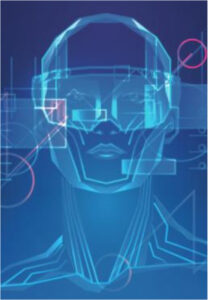~ TIRTH PARMAR
The biggest news in the tech industry right now is that “Facebook” is renaming itself “Meta”. But why exactly is Facebook rebranding? It is doing this to embrace a futuristic idea. The idea of a universal “metaverse”. But first, let’s see what exactly is ‘metaverse’.
The metaverse is a hypothetical replica of the internet. Its goal is to be able to create 3D virtual environments that people can easily access on the internet through virtual and augmented reality devices and headsets. Neal Stephenson coined the term “metaverse” in his fantasy novel “Snow Crash,” in which he visualized it as a virtually realistic environment where lifelike characters could meet up and do a lot of different activities. We have already seen a few examples of a metaverse in movies like The Matrix, where people visit these virtual realities with the help of a device or gadget. The vision behind Metaverse is to create a virtual reality where people don’t just join to work with their colleagues but can also catch up with friends through tons of offerings like virtual concerts and open-world games. As the metaverse expands and more people join in, it will become an augmented virtual world for you to coexist in. A few examples of the applications of the metaverse can be seen in the popular video game Fortnite, where they have held music concerts and trailer debuts on the virtual platform of the game. They also plan on implementing their MetaHuman Creator, which could develop photorealistic digital humans, and that could be how we customize our digital doppelgangers in future open-world games.
There are going to be several business opportunities in the metaverse too, some of which are further explained:
Selling Virtual Products
A virtual product is going to be an exclusively digital representation of a product in the metaverse that can be used for certain activities. It could be a virtual representation of a product that can be used in the real world or just one created for the virtual world. While these products don’t appear to be real in the traditional sense, they are real in the sense that real people are ready to spend their money on them. For many companies, the implementation of virtual products might be obvious. Imagine someone buying a high-end Ferrari in a racing simulator to get an advantage over its competitors. It will be very similar to that. People will buy these virtual products in the metaverse to get an edge over others. The message is simple. If you can make and sell products in the real world, there’s probably a way to make and sell those products in the metaverse too. And as we progress toward a more immersive and technologically advanced society, the value of these products will only rise.
Reaching Massive Audiences
Globally, the video game industry is growing rapidly and is already larger than the sports and film industries combined. All of us have at least once heard about the skin of our favorite movie character or favorite sports player coming to Fortnite. This is happening because you can reach a much larger audience through these platforms than ever before. And all of this will just increase once the metaverse is here. Companies are now using NFTs and different types of virtual products to reach these younger audiences.
Protecting Your IP

It is very easy to imitate or counterfeit a virtual product online, so everyone’s main concern is how to maintain and evaluate a product’s value. Counterfeiting, or imitation, is also a major problem faced by real-world industries all around the world, from clothing to art. In the virtual world, it gets even more complicated, as it is very easy to counterfeit just about anything. In the real world, what differentiates a real Rolex from a counterfeit is the attention to detail, the materials and the construction of the watch. In a virtual world, it’s possible to create “virtually” identical copies of products with no distinctions in their product files whatsoever. So, to maintain and enforce the scarcity and exclusivity of virtual products, NFTs and blockchains were created. The blockchain seems complicated at first, but the best way to describe it is as a record of ownership for a particular virtual asset, which may be a virtual product, cryptocurrency, or NFT.
When you compare a blockchain to other records of ownership, the main difference is that no one owns the blockchain. It’s decentralized, which means no one has the authority to manipulate, alter, or destroy it. So, if you own one bitcoin, you can’t spend it twice as an identical record for that coin can’t be created, and that unit is directly connected to a record in the blockchain. When you spend that bitcoin or give it to someone else in exchange for something, what you are really giving them is the unique reference that is linked to its record in the blockchain. In this sense, NFTs are similar to any other unit of cryptocurrency in the sense that they are generated and protected via blockchain technology. However, there is no “fungible” or tradeable value assigned to an NFT in itself. As such, it can be considered to have the same value as every other bitcoin in existence, and as such, it can be indexed to a value relative to other currencies or commodities too. An NFT has no value in itself. It’s simply an unalterable and indestructible record of ownership that can point to any virtual asset, from a piece of 3D digital art to a clip of Messi scoring in the UCL finals.

A NFT will serve as a secure means of asserting ownership over a virtual asset. If a virtual product is protected via a NFT, the NFT points directly to that product file in the blockchain and not to any other copy or forgery of that product. When you sell a NFT, you are selling the proof of ownership of the asset. This can be very useful in the metaverse as it could act as a medium of exchange for products and services. Aside from protecting products in virtual spaces, NFTs can also be used to protect physical products from counterfeiting and unauthorized reselling. For example, a major problem facing e-commerce companies today is the unauthorized selling of their products in major markets. One way to fight this would be to apply an NFT-linked virtual thread to the products to authorize sales channels, that would act as a verifiable certificate of authenticity.
So go ahead, enter the metaverse, the other world which happens to be just as real and, perhaps, just as encompassing as the one we live in!
About the Author:
Tirth is in the freshman year at IAQS. He loves to read and research about technology and new discoveries in the fields of science and maths.
References:






